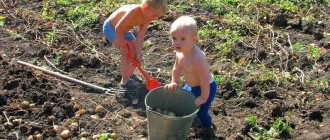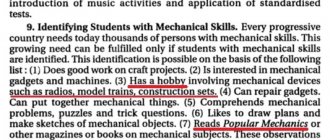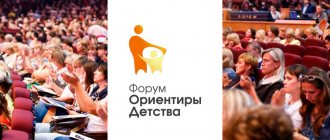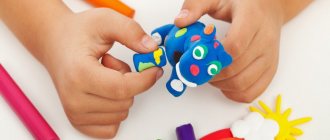Educational classes with a teacher
In addition to the fact that there is a health corner in kindergarten, the teachers themselves must clearly show and explain everything to the kids. Day after day you need to repeat the necessary rules. It is useful not only to talk about, but also to show, for example, why brush your teeth and how to do it correctly, what to wear in summer and what in winter, what vaccinations are, etc. You can also demonstrate the materials themselves (brush, clothes, doctor’s kit and other). It is worth involving children in improvised scenes and teaching them to use objects for their intended purpose. Hygiene rules, for example regarding brushing teeth, can also be outlined in the health corner.
Every day or at least every other day you need to set aside time for physical education. You can include fun playful exercises in each lesson. The children's room should have sports equipment - balls, hoops, jump ropes, massage mats, bolsters, a horizontal bar or wall bars. Teachers are required to explain to children how to use all this. Information on how you can exercise with your baby at home can also be posted in the health corner.
Sports family – healthy child
Parents are the most significant people for everyone throughout their lives. For a small child, they are role models. The child’s life activities directly depend on their lifestyle. The health corner should also contain information about a healthy lifestyle and the need for parents and children to spend time together. Parents need to cultivate in their child the need to take care of their body, eat well and properly, be active and play sports. At the same time, they themselves must adhere to the same attitudes, accept them and demonstrate them in behavior.
It is not necessary to fanatically follow the idea that a healthy body means a healthy mind. But we also must not forget about the need for vitamins, the quality of food as a source of energy, and light gymnastics that can be done even with a baby and which will strengthen his health - these ideas are definitely needed convey to parents.
Stages of drawing a poster
Let's look at the main sequence in drawing a poster, where you should start:
- Prepare an A4 sheet, this format will highlight your work among the rest and attract more attention
- You should not draw with pencils - they will not highlight the drawing and characters very much; draw only with bright colors, it can be gouache or felt-tip pens.
- The sketch is drawn with a pencil, then outlined and painted at the end with the selected material.
- Before you draw on the main poster, you should practice on a piece of paper; work out some individual figures well so that you don’t have any difficulties when drawing on the poster.
- An additional material should be a ruler; it is an excellent stationery item to make all the lines neat and accurate.
Requirements for formatting text messages
A health corner in a kindergarten can be made in any style and contain elements of creativity, but there are a number of general recommendations to increase its effectiveness:
- Simplicity and accessibility of the material provided: absence of unknown terms or incomprehensible phrases, clarity of presentation.
- Large font and certain colors in the design (preferably contrasting compared to the background, and not too bright). The text should be well presented visually, this will improve its perception.
- Interesting, attention-grabbing headlines. You can write abstractly - short and at the same time meaningful titles will be remembered immediately.
- The text that will be placed in the health corner (photos will help to dilute it) must be literate. Don't write too much different information. Let these be short passages illustrated with thematic images.
Project “Health is given by Aibolit” in the senior group of preschool educational institutions
Project on the topic: “Aibolit gives health” in the senior group. Project duration
: short term.
Project type
: group, frontal.
Project participants:
teachers, older children, parents.
Relevance of the project
: Every person has great opportunities to strengthen and maintain their health, to maintain capacity for work, physical activity and vigor until old age. The most pressing problem today is preserving and strengthening the health of children. V.A. Sukhomlinsky wrote: “I am not afraid to repeat again and again: caring for the health of a child is the most important work of a teacher.” Health is considered as complete physical, mental and social well-being, as a harmonious state of the body, which allows a person to be active in his life and achieve success in various activities. It is well known that the health of a nation is one of the most important indicators of its well-being. The future of Russia depends on the health of the younger generation.
The issues of forming the foundations of a healthy lifestyle in preschoolers and the need for daily physical activity are reflected in all currently existing education and training programs. Along with work on hardening, the formation of cultural and hygienic skills and basic movements, these programs set the task of teaching the child to take care of his health and safety.
Target:
Raising a psychophysically healthy, intellectually developed, socially active child.
Tasks:
— preserve and strengthen the physical and mental health of children;
- form initial ideas about a healthy lifestyle;
— ensure the psychophysical well-being of children and form a conscious attitude towards their own health;
- create a developmental subject environment of the preschool educational institution, a favorable atmosphere;
— develop and improve children’s motor skills;
- cultivate the desire to be healthy;
— to form responsibility among parents and pupils for maintaining and promoting health;
— to cultivate good feelings, emotional responsiveness, and the ability to distinguish between the emotional states and moods of others.
Expected result of the project:
— organization of a meaningful health-preserving developmental environment in the group;
— reducing morbidity and increasing the level of health of children;
- the formation of a hygienic culture in children and the presence of a need for a healthy lifestyle (the ability to maintain a daily routine, knowledge about proper nutrition and vitamins, etc.);
- active assistance and interest of parents in organizing work to improve the health of children.
Activities
: gaming, productive, musical and artistic, cognitive, constructive activities; looking at illustrations and books; didactic games, conversations with children, solving problem game situations, artistic creativity.
Integration by region:
“Physical development”, “Social and communicative development”, “Cognitive development”, “Artistic and aesthetic development”, “Speech development”.
Creation of a thematic development environment, gradually replenished and enriched as the topic is mastered.
Contents of the project.
Stage 1.
- study methodological and fiction literature on the topic;
- select illustrative material on this topic, toys, attributes for gaming, educational, theatrical activities;
- draw up a plan of activities for each day, a card index of poems, riddles, proverbs, visual and breathing exercises;
— to involve parents in joint work to develop a culture of health in children of senior preschool age;
At this stage it is necessary to identify the problem:
— How to maintain your health?
Stage 2
– Basic
Work with children by day of the week:
Monday – “Keep your health yourself”
Target:
To instill in children a conscious attitude towards their body:
- Regime moment “Visiting Doctor Aibolit.”
- learning proverbs and sayings about health;
- looking at illustrations: “Why did the guys get sick”
- Conversation: “What do I know about health?”
- Didactic games “Beneficial and harmful”, “What we need for health” (with a ball)
- Plot-role-playing game “Hospital” Reading fiction Shorygina T. “Exercise and colds”
- Outdoor games: “Guess who’s calling”, “Owl”.
Tuesday – “Me and my body”
Target:
To form the concept that a healthy body needs physical education, conditioning, and proper nutrition.
- Conversation “My body”
- Examination of illustrations “Human Body”, “Human Organs”.
- Looking at portraits of people of different appearances.
- Making riddles about body parts.
- Didactic games: “Mirror”, “Photo sketch”.
- Story-based role-playing game "Hospital".
- Observation on a walk “How are we different from children of younger groups?”
- Modeling "My Family".
- Reading fiction by Zhabrov E. “Be sporty and healthy.”
- Outdoor games: “Needle, thread, knot”, “Jolly guys”.
Wednesday – “Vitamin Day”
Target:
Help children understand that human health depends on proper nutrition, explain that food should not only be tasty, but also healthy.
- Excursion to the kitchen - observing the work of the cook, strengthening vocabulary on the topics: “products”, “vegetables”, “fruits”.
- Drawing “Vegetables and fruits are healthy foods.”
- Conversation: “I love vitamins, I want to be healthy.”
- Didactic games: “Make a vitamin salad”, “Fruit salad”.
- Coloring pictures with vegetables and fruits.
- Reading fiction: Mikhalkov S. “About a girl who ate poorly”, “Vegetables”.
- Outdoor games: “Pass the ball”, “Centipede”.
Thursday - “We value order - we adhere to our regime.”
Target:
Introduce children to the daily routine. Show the importance of adherence to the regime in promoting the health of each person; consolidate the concept of the importance of the daily routine; to cultivate the desire to adhere to the rules for its implementation, to develop memory and thinking, the ability to reason, and draw conclusions.
- Conversation “Our faithful friends - daily routine”
- Conversation: “Why are we sleeping?”
- Reading fiction: “Business Man” by L. Ryzhov, “On the contrary” by E. Karganov, Grozovsky M. “Daily Routine”, Shorygina T. “Why follow the regime”,
- Conversation: “Beautiful posture”
- Drawing: “My daily routine at home”
- Didactic games: “When it happens”, “Exact time”, “My day”.
- Outdoor games: “Don’t sleep, don’t yawn”, “Day - night”, “Live hours”.
Friday – “If you want to be healthy, toughen up!”
Target:
Introduce children to the rules of hardening and its benefits for the body.
- Conversation: “Sun, air and water are our best friends.”
- Carrying out hardening procedures with children - “About how we harden in a group.”
- Reading fiction by Zhabrov E. “Be sporty and healthy.”
- Entertainment “Being healthy is great!”
Stage 3 is the final stage.
Joint sports entertainment “Being healthy is great!” — consolidation of previously acquired knowledge on maintaining and promoting health; show the benefits of a healthy lifestyle, make children want to engage in hardening their bodies and sports.
Interaction with parents:
1. Acquaintance with the project activities, inclusion of parents in the course of the project.
2. Consultations: “Tempering yourself correctly”, “Harmless sweets”
Literature:
- Golitsina N.S., Shumova I.M. “Education of the fundamentals of a healthy lifestyle in children” - M., “Scriptorium 2003”, 2010.
- Lobodin V.T., Fedorenko A.D., Alexandrova G.V. “In the land of health” - M., “MOSAIC-SYNTHESIS”, 2011.
- Utrobina K.K. “Entertaining physical education for preschoolers” - M., Gnom, 2003.
- Shebeko N.V. “Variable physical education classes in kindergarten” - M., Publishing House of the Institute of Psychotherapy, 2003.
- Shorygina T.A. “Conversations about health” - M., “Sfera”, 2008.



